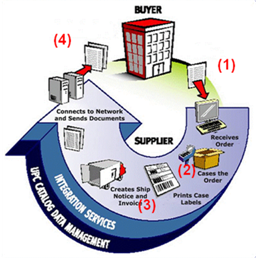What is EDI?
Electronic Data Interchange (EDI) refers to the structured transmission of data between organizations electronically. It is used to transfer electronic documents from one computer system to another, i.e. from one trading partner to another trading partner. Benefits can be seen in many areas, including reduced time delays, reduced labor costs, improved data accuracy and increased information accessibility.
North American standards are currently developed and maintained by a private not-for-profit organization called ANSI (American National Standards Institute). In the late 1990s, international format standards were established and introduced to facilitate business activity.
"EDI saves money and time because transactions can be transmitted from one information system to another through a telecommunications network, eliminating the printing and handling of paper at one end and the inputting of data at the other."
—Kenneth C. Laudon and Jane Price Laudon, from Management Information Systems: A Contemporary Perspective, 1990.
 Typical Retail Process:
Typical Retail Process:
- Trading Partner transmits PO (850)
- Pick Tickets and Labels (UCC-128)
- Wholesaler transmits Advance Ship Notice ASN (856)
- Wholesaler transmits Invoice (810)
Additional Requirements:
- UCC Block ID is typically required
- Product Catalog up load (832)
- Hang Tags / Stickers (VICS)
- EDI testing
- Label Validation
- Avoid Chargebacks!
How Do I Get Started?
Getting started is easy! We will help you through these simple steps and guide you along the way.
1.) Work with your account manager to complete the Spring Systems new customer setup forms.
2.) Setup your vendor account and test it with your retailer. Spring Systems will act as your EDI team and take care of all EDI and label setup, testing, and verification requirements.
Please fill out the form below to get started or ask any questions you might have. If you prefer, you can call (888) 275-2160, option 2.
Need More Info?
Browse through some of our articles:

